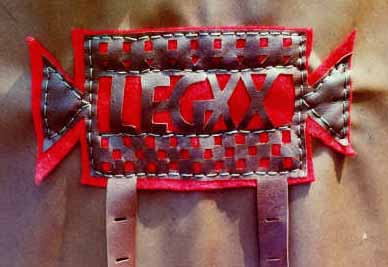
The boss is covered by a separate dome-shaped piece, made from a three-quarter circle of leather stitched into a cone with a whip stitch, then soaked and stretched over the boss to give it more of a dome shape. (If your boss is steel, place a plastic bag over it before stretching wet leather over it, to prevent rust!) When sewn in place, the leather dome is often surrounded by a separate ring with a zigzag outer edge.

The edge of the cover is turned back, about 3/4", and sewn down with a simple running stitch to create the drawstring casing. Thread a strong cord through (If you are careful you can fold the leather around the drawstring and stitch it down without stitching through the cord--this will prevent the tedium of threading the cord through the finished casing.) On surviving original examples, the corners are rounded off a little and the casing simply continues around. When I tried this on mine, however, the leather was too stiff at the corner to allow it to "draw down" neatly. Oiling the leather heavily, and softening it by working and flexing probably would have solved most of that, but I trimmed off the corner instead (not too much!).



